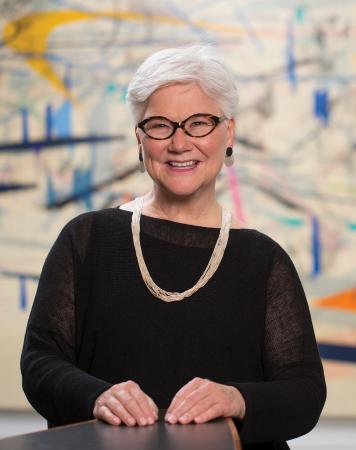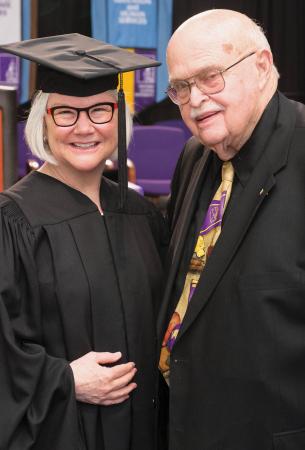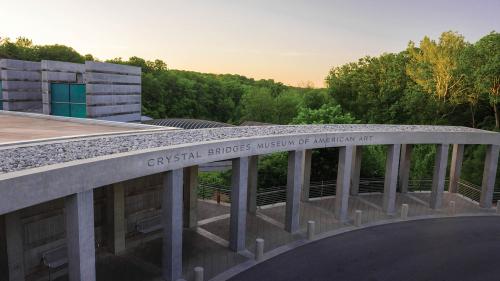University News
A Lifetime of New Experiences: From Music to Art, Alumna's Career Comes Full Circle
March 30, 2018
From the Spring 2018 issue of Western: The Magazine for Alumni of Western Illinois University
---
By Darcie Dyer-Shinberger & Brad Bainter
For Sandra Keiser Edwards MS-Ed '74, the deputy director of the famed Crystal Bridges Museum of American Art in Bentonville, AR, it wasn't a matter of going to college, it was only a matter of where.
Edwards grew up in the Shenandoah Valley of Virginia, one of four children. Education was valued, and it was the Keisers' gift to their children that "no one could take away."
"Higher education was expected for each one of us. My family was a great believer in a liberal arts education and we were encouraged to pursue a degree that would allow us to not only survive, but thrive," she remembered.
Edwards selected Lenoir-Rhyne College (now Lenoir Rhyne University) in Hickory, NC, where she pursued a bachelor's degree in sociology and German. It was at Lenore where she first dipped her toes into the programming and collegiate entertainment waters.
"I was really active in student activities, and I joined the concert committee my freshman year. I stuck with that, and was an active part of the founding of NEC (now called NACA)," she said. "We were among the schools in the U.S. to work cooperatively with the music agencies to create block booking and more efficient and effective ways to produce shows on campuses. Opal Moretz, the director of our student union, made certain I was an integral part of the dialogue and I became a student member of the board of directors. It was a remarkable look into the music industry and I was able to gain a lot of experience."
It was during that time that she realized there was a future for her in the student activities and collegiate entertainment realm, but she also knew there were not a lot of options in that particular field for a female in the 1970s. And then she met Western's Bill Brattain – aka "Dr. B" – who was one of NEC's founding members and served with her on the board.
"He encouraged me to stay in the field and offered me an assistantship at Western in the pop concerts program of Student Activities, so after Lenoir-Rhyne, I packed up and moved to Macomb, IL to begin my master's degree," Edwards said. "It was really a dynamic time in student activities. Students in the 1970s were demanding and expecting great concerts, and WIU was a hotbed in large part because of Dr. B."
Edwards said her first year at Western was an "amazing time" both socially and culturally.
"It was a whole learning shift. I was unfamiliar with Illinois. WIU was quite large, about 14,000 students, and I was coming from a very small liberal arts college," she added. "But it was so wonderful, and I thrived on the challenges it presented. The students here were political, they were savvy about music, and we had a hands-on student activities program. We were fearless and our experiences here really prepared those of us in Student Activities to take that next step as professionals."
She worked at Western only one year while in graduate school, finishing her degree in college student personnel in 12 months, but that was enough to propel her into the field professionally as her experiences at WIU provided active leadership opportunities. As a woman in the 70s, Edwards said it was both fascinating and encouraging.
"I loved my studies, but it was the practical applications in the Office of Student Activities that shaped me professionally. And working for Dr. B? Well, everyone in the entertainment business knew WIU because of Bill Brattain. He was a leader in the field and it was an honor to learn from him and to work for him," she said.
After graduating, the University of Tennessee recruited her, but then Dr. B came calling again.
"A position had opened at Western, so I came back to WIU as a full-time professional programmer," she explained. "We had a terrific team—Elise Jordan, Dave Kratzer '70, Gil Baker, Jim Miner '72 MS '73 and so many others. Just a great group of colleagues working together in a student-run, robust organization. We all learned leadership and life skills here."
Edwards recalled there were so many good acts that knew about WIU. They knew they'd get a great audience and they showed up ready to perform. She added the community also supported arts and entertainment at Western, knowing that performances would be top-notch. And this was a time when there was only a two-lane highway to Macomb.
"We had family-oriented shows, we had niche shows, we had major performers and we hosted a significant Blues Fest that was totally student run," she pointed out. "I remember rocking at Western Hall with Humble Pie. In fact, I still have my t-shirt," Edwards laughed. "We promoted the mainstream to the obscure to the up-and-coming. Western Hall hosted real rock and roll."
After another good run at Western, in 1976, Edwards was recruited by Southwest Missouri State University (Springfield, MO) to serve as associate director for a new venue, the John Q. Hammond Center, a student health club (including courts for basketball, weights and handball and a swimming pool) and an NCAA-competitive arena for basketball that doubled as a performance hall. Edwards ran the center's programming, booking acts and events from the Harlem Globetrotters to the spectrum of music. She stayed on for six years, and began looking at even larger arenas in larger cities.
"In the early 80s, municipalities and local governments began contracting major corporate food and hotel enterprises to manage their arenas," she explained. "I'd been promoting shows for 10 years, during which time I had met my husband, Clay, who had also been in the music business. We both decided it was time to explore other options, so we became the management team for the Shreveport Symphony (LA). We switched gears from rock and roll to classical."
Sandy managed the organization as its executive director, while Clay created the development program. Together, they expanded the organization's program, and then, the duo was on the road again, this time to Penn State, for the next stage of their careers. Clay wanted to expand his practice of private gift fundraising and the director of development for Penn State's College of Arts and Architecture. Sandy joined the development profession first as director of development for Penn State's public broadcasting services. The university brought all external services under one organization and she was given the responsibility to create the first comprehensive advancement program in the field of outreach at a university, which included continuing and distance education and cooperative extension. It was in this new role that Edwards became part of the management team that created Penn State's World Campus, a virtual university for students at a distance from the physical location.
The Penn State experience led to bigger and better things as the University of Arkansas lured the Edwards' south, where the pair designed, launched and directed the university's "Campaign for the 21st Century."
"It was unusual for a husband-and-wife team to be recruited as co-administrator, but it was the highlight of our lives to put our skills together into a precedent-setting effort for the university," she said. "It was a privilege to work alongside Clay."
After nine years at the University of Arkansas, and overseeing a successful campaign raising more than $1 billion for academic programs, Clay suddenly passed away in January 2007. The Edwards' had spent 24 years working together professionally, and Sandy was unsure what her next steps would be.
"Just when I was wondering what I was going to do, the Walton Family Foundation, with whom we had worked at the University of Arkansas, had recently announced the development of Crystal Bridges Museum of American Art and inquired about my interest," Edwards recalled. "I was in a new phase in my life, and it took a while to determine what might be the best next move. I continue to be grateful that this remarkable opportunity presented itself at just the right time."
She was hired as the associate director of the museum, which was building the facility, the collection and the organization simultaneously. The project had been announced, and the museum needed someone to raise awareness and provide on-going information for a project that was being constructed in a deep ravine surrounded by woods—unseen by the public.
"One of the best actions we took was creating an overlook where the community and visitors to the area could see the day-to-day progress of the museum evolving," Edwards said.
The mission of the museum is to "welcome all to celebrate the American spirit in a setting that unites the power of art with the beauty of nature."
"We had a broad interpretation of how to program the museum. I was really attracted to the building of a new museum and creating this. I was well-positioned at this time in my career to take this on," she added. "I really like taking a concept, and making it real."
Early on, one of the challenges, Edwards explained, was the museum's location in what's known as the "Arkansas Ozarks."
"Our priority was creating awareness and acceptance – from the general public, as well as the museum field and art world – that what we were doing was of value. A project of this scope cannot be done in a vacuum," she pointed out. "We celebrated our sixth anniversary Nov. 11, 2017, and we have welcomed more than 3.5 million guests. We have an open and receptive community and region that are well-prepared to meet the needs of visitors. It's working."
Founded in 2005 by the Walton Family Foundation, Crystal Bridges was designed by world-renowned architect Moshe Safdie.
Crystal Bridges' permanent collection spans five centuries of American masterworks ranging from the Colonial era to the current day. Included within the collection are iconic images such as Asher B. Durand's "Kindred Spirits," Norman Rockwell's "Rosie the Riveter," and Andy Warhol's "Coca-Cola [3]"—each reflecting a distinct moment in American artistic evolution—as well as major works by modern and contemporary American artists, including Georgia O'Keeffe, John Baldessari and James Turrell. The permanent collection, which continues to grow through a strategic acquisition plan, is on view year-round and is enhanced by an array of temporary exhibitions.
When asked to name her favorite work – or works of art – at Crystal Bridges, Edwards said, with a laugh, "that's a hard question."
"If I had to answer, I'd say Louise Bourgeois' bronze spider that greets all guests in our courtyard or, perhaps, Martin Johnson Heade's 'Haystack.' Or, the evocative 'Oh, Mary, Don't You Weep' by Charles White. But everywhere my eye lands at Crystal Bridges, I see something different, something new, something that resonates," she said. "It's hard to pick just one. I can't pick just one. I appreciate each work and the special meaning it brings to our collection.
"As for the performers I've seen or listened to, I've always admired guitarists like Eric Clapton and Santana, and bands like the Doobie Brothers. I first heard the Doobie Brothers and Bonnie Raitt in a record company preview and booked them on the spot. And Southern rock, like the Allman Brothers. I would say they're one of my favorites," Edwards added. "And while I'm not in the music business anymore, I try to stay open to the acts of today, but I've enjoyed the maturing of my favorite artists over the years."
Much like the "maturing" of some of her favorite bands over the years, from Sting to the Eagles to Aerosmith, performers who have continued to hone their craft and develop to stay relevant, Edwards said she continues to learn and grow professionally.
"One of the most rewarding aspects of my work is standing in front of a work of art with others and sharing our unique perspectives. Everyone's opinion is valid," she said. "I encourage young people to find a balance between what they're passionate about and understanding others' perspectives. When you can share your passion with others and be receptive to their thoughts, your appreciation and understanding are expanded.
"I've learned a lot about myself over the years. I thrive on stability born from chaos. And I think it all started at Western," Edwards reminisced. "I thrived working with Bill Brattain and my Western colleagues and my work fueled my passion. WIU gave me back more than I ever expected. Driving my VW bus across the prairie to Macomb, IL in 1973 sparked a transformation in my thinking that began a lifetime of seeking out new experiences."
Posted By: Darcie Shinberger (U-Communications@wiu.edu)
Office of University Communications & Marketing




Connect with us: